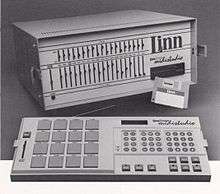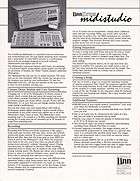LinnDrum Midistudio
The LinnDrum Midistudio (also known as the Midistudio) was going to be an electronic musical instrument produced by Linn Electronics as the successor to the ill-fated Linn 9000, which was an integrated digital sampling drum machine and MIDI sequencer. The Midistudio is essentially a rack-mount version of the Linn 9000 with some improvements.[1] It was revealed at the 1986 Winter NAMM Show in January[2] for a list price of $5,990.[1] However, it never went into production because Linn Electronics went out of business in February 1986.[3]
| LinnDrum Midistudio | |
|---|---|
 LinnDrum Midistudio integrated digital drum machine and MIDI keyboard recorder. | |
| Manufacturer | Linn Electronics |
| Dates | 1986 |
| Price | US $5,990 |
| Technical specifications | |
| Polyphony | polyphonic 13 voices |
| Timbrality | multitimbral 16 voices |
| Synthesis type | 8 bit Digital Samples / 10 kHz - 50kHz |
| Storage memory | 50 Drum Sequences, 50 MIDI Sequences - 10,490 notes |
| Effects | Individual level, pan, tuning for all sounds |
| Input/output | |
| Keyboard | 16 large (1.25 inch square) velocity and pressure sensitive rubber pads |
| External control | MIDI In/Out/Thru, Foot Switch x2, Foot Controller x1 (hi-hat), Sync Tone In/Out, trigger outputs x2, trigger inputs x16 |
Apparently, one prototype is in existence and was placed up for auction in 2008.
History
The LinnDrum Midistudio and the LinnSequencer used the same flawed operating system used in the ill-fated Linn 9000,[4] released in 1984. Chronic software bugs[5][6] led to a reputation for unreliability and contributed to the eventual demise of Linn Electronics.[7][8]
The similarities between the LinnDrum Midistudio and the Akai MPC series, starting with the Akai MPC60, leads many to perceive a family resemblance.[9][10][11] From a strictly chronological standpoint, the LinnDrum Midistudio did come after the Linn 9000 and before the Akai MPC60 and might well be called a step in the evolution of the Music Production Controllers of today.
At the time of writing (2015), many products, mostly software, bear the name "Midistudio". But in 1986, the LinnDrum Midistudio was, perhaps, one of the very first to brandish that moniker.
Features
The LinnDrum Midistudio has sixteen 8-bit 10 kHz ~ 50 kHz digitally sampled drum sounds: bass, snare, cross stick, hihat, two crash symbols, two ride symbols, four toms, cabasa, tambourine, cowbell and clap. The Midistudio has virtually all the same features as the Linn 9000. Also, many optional 9000 features (like digital sampling capability and a floppy disk drive) are standard on the Midistudio.[1]
Both machines have large (1.25-inch-square) velocity- and pressure-sensitive rubber performance pads. But the 9000 has 18 pads in a three-high by six-wide pattern, where the Midistudio has 16 pads in the distinctive, four-by-four pattern, that would become the hallmark of the Akai MPC series of Music Production Centers, starting with the Akai MPC60.
The Midistudio has some improvements, including a sampling rate of 10 kHz - 50 kHz (the 9000 is 11 kHz - 37 kHz) and (optionally) 16 trigger inputs (6 standard, optionally 12 maximum on the 9000).
The most distinctive difference between the machines is that the Midistudio has a rack-mountable chassis with a separate "lap pad" control panel that doubles as a protective cover for front panel in the rack-mount unit. The 9000 is a more traditional, one-piece drum machine chassis. They both feature an onboard mixer section providing real-time control over volume and pan. On the Midistudio, the sliders are in the rack, whereas on the 9000, they are on the one-piece, conventional drum machine control panel.
Brochure and gallery



References
- "MidiStudio - Synthony Music's Synth & Midi Museum". Archived from the original on 1999-04-20. Retrieved 2015-02-22.
- "For Sale: Roger Linn's original prototype MPC from 1986".
- "Roger Linn Design - Past Products Museum".
- Linn, Roger. "[Q] What will happen to the new product, the LinnDrum Midistudio? [A] No Midistudios were ever shipped. If I cannot re-start Linn, there is a good chance that some other company will purchase the designs to both the Midistudio and the LinnSequencer and then manufacture and distribute them. In that event, there is also a chance that the company might make further software updates for the 9000 available since the software for all three products is nearly the same". Bobby Nathan's Keyboard Magazine "In The Studio" Article #17 "What Happened to The Linn 9000". Archived from the original on 2015-01-08. Retrieved 2015-02-22.
- "...but bugged by many OS troubles and technical issues". Polynominal.
- "...it was plagued with operating system bugs..." Total Trash. The Linn 9000 Home Page.
- Linn, Roger. "What happened? We simply ran out of money and were unable to get more. Why? There were a number of reasons. The 9000 had technical problems early on and was expensive to re-engineer, manufacturer and service; we had strong competition; we had no investment financing; and we were experiencing all the classic "growing pains" of a new business". Bobby Nathan's Keyboard Magazine "In The Studio" Article #17 "What Happened to The Linn 9000". Archived from the original on 2015-01-08. Retrieved 2015-02-22.
- "one the most unreliable and buggy machine ever made, in fact this ground-breaking and expensive project bankrupted the Linn company". Polynominal.
- "So, was the Midistudio the direct descendent to the MPC range, that then continued on to evolve into my broken down MPC2000xl and beyond? I'm gonna say yes, even if it never made it into production. The 4x4 pads, the beige colouring, and the few references I've found online is good enough evidence to me". Linn Electronics Inc. LinnDrum Midistudio "Put a complete studio in your lap." ad, Keyboard 1986 - Retro Synth Ads - Atom. May 19, 2011. Retrieved February 21, 2015.
- "Blogged: '86 LinnDrum Midistudio - father to @Akai_Pro 's MPC? 4x4 pads and color!". RetroSynthAds. May 19, 2014. Retrieved February 21, 2015.
- "The LinnDrum Midistudio looks like the true predecessor to the MPC, they moved from the 6x3 pad layout of the Linn 9000 to the familiar 4x4 pad layout with the LinnDrum Midistudio prototype, and the remote pad surface seems to have the Akai cream colour, along with the MPC style layout of pads/transport/controls/etc., just before Linn went broke... The Linn 9000, Linn Sequencer, LinnDrum Midistudio, and Akai ADR15 would represent the refinement of Linn's previous ideas/products into the MPC design, possibly with the sampled drum idea coming from the replaceable ROM sound chips in the LinnDrum". Akai MPC Forums - Researching a book on the MPC60 - Thoughts? : MPC3000, MPC60. October 24, 2012. Retrieved February 21, 2015.